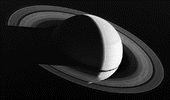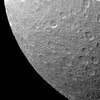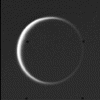
 Saturn
Saturn

Planet Profile
Mass ............................................ 5.69 X 1026 kg Diameter ............................................ 120,660 km Mean density ............................................0.69 gm/cm3 Escape velocity ...................................... 35,600 m/s Average distance from Sun (AU)......................... 9.539 Rotation period (length of day in Earth hours).......... 10.2 Revolution period (length of year in Earth years)...... 29.46 Obliquity (tilt of axis)................................ 26.7° Orbit inclination ...................................... 2.49° Orbit eccentricity (deviation from circular)........... 0.056 Mean temperature ......................................... 88 °K Visual geometric albedo (reflectivity).................. 0.46 Atmospheric components...........................97% hydrogen 3% helium 0.05% methane Rings........................................................ Saturn's rings are 270,000 km in diameter, but only a few hundred meters thick. Particles are centimeters to decameters in size and are made of ice (some may be covered with ice); there are traces of silicate and carbon minerals. There are four main ring groups and three more faint, narrow ring groups separated by gaps called divisions.

 Clouds and Spokes (Enlarge view)
Clouds and Spokes (Enlarge view)Several dark spoke-like features can be seen across the broad B ring (left of planet). The moons Rhea and Dione appear as dots below and below left of Saturn, respectively. This photo was taken July 21, 1981, when Voyager 2 was 33.9 million km from the planet. Voyager 2 made its closest approach to Saturn on August 25, 1981.
 Rings in Shadow (Enlarge view)
Rings in Shadow (Enlarge view)This image of Saturn was taken while the spacecraft was departing the Saturnian system. The planet's disk casts a shadow across the ring system. The visible side of the rings is directly illuminated by the sun. The broad dark band in the rings separates the outer A ring from the inner B ring. The C ring is much fainter and closer to the planet. The narrow F ring is just barely visible outside the A ring.
 Mimas
MimasMimas, the innermost of Saturn's larger moons, was nearly shattered by a cataclysmic impact. From observing Mimas' giant crater Herschel, scientists speculate that the inner satellites of the outer planets have, in fact, been shattered and gravitationally reassembled many times in their geologic history. Herschel's walls are approximately 5 km high, parts of its floor measure 10 km deep, and its central peak rises 6 km above the crater floor. The diameter of this moon is 394 km.
 Enceladus
EnceladusThe surface of Enceladus resembles that of Jupiter's satellite Ganymede. Some areas are smooth and uncratered while others contain impact craters up to 35 km in diameter. Linear sets of grooves tens of kilometers long traverse the surface and are probably faults resulting from deformation of the crust. The uncratered regions are geologically young and may indicate that Enceladus has experienced a period of relatively recent internal melting. The satellite is about 500 km in diameter and has the brightest surface of any of Saturn's satellites.
 Tethys
TethysTethys is approximately 1100 km in diameter and is densely populated with impact craters. One of these, above center, is surrounded by a hummocky ejecta blanket. Ithaca Chasma stretches from left center up toward the crater, covering three quarters of the circumference of Tethys.
 Dione
DioneImpact craters are visible records of the collision of cosmic debris. On Dione, the largest crater is less than 100 km (62 mi) in diameter and shows a well-developed central peak. The sinuous valleys may have formed when faults broke the moon's icy crust. Images in this mosaic were taken from a range of 162,000 km on November 12, 1980.
 Rhea
RheaThe density of Saturn's moon Rhea suggests that it is largely made of water ice with a small proportion of rocky material. Note that the ancient impact scars that ripped through the ice early after the formation of the solar system are still preserved to this day.
 Titan
TitanThis view of Saturn's largest satellite was taken from a position looking almost directly back toward the Sun. Titan's hydrocarbon-rich nitrogen atmosphere has a pressure comparable to the Earth's -- placing it in rare company, because it is the only moon in the solar system with a heavy atmosphere. The surface of Titan is obscured due to a deep cloud layer. The diameter of Titan is 5150 km, larger than that of Mercury.
 Hyperion
HyperionScientists believe that this small irregular satellite may once have been a piece of a larger satellite. Hyperion measures approximately 370 x 280 x 225 km and orbits outside Titan. Pulled and tugged by the constantly shifting gravitational forces of Saturn's other moons, Hyperion's tumbling rotation changes chaotically, and cannot be predicted very far into the future with any accuracy.
 Iapetus
IapetusThe leading hemisphere of Iapetus is covered by extremely dark material, whereas the trailing hemisphere is covered with bright material. This dichotomy puzzled the discoverer, astronomer Giovanni Cassini, who noted that the satellite was visible only from one side of its orbit. Two models have been proposed to explain this. The first proposes that dark material from Phoebe, a dark exterior moon, falls onto Iapetus from orbit. The second model says that the dark material erupted from the interior of Iapetus into a low area in the leading hemisphere. (And, Arthur C. Clarke once proposed a third, considerably more interesting explanation, in his novel 2001.)
